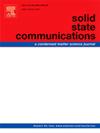Superconductivity in layered dichalcogenide Pt0.02TaSe2 single crystals
IF 2.4
4区 物理与天体物理
Q3 PHYSICS, CONDENSED MATTER
引用次数: 0
Abstract
We report on the magneto-transport properties of the Pt-doped transition metal 2H-TaSe2 single crystals at temperatures down to 20 mK. The iodine vapor transport technique was employed to grow the desired size of single-crystal dichalcogenides Pt0.02TaSe2 samples. Then, scenarios behind the superconductivity were traced by extensive magneto-transport measurements performed in axial and angular field sweep modes. Temperature sweep revealed a peculiar metallic state at high-T accompanied by an incommensurate charge density wave (ICDW) state at ≈ 130K and a commensurate charge density wave (CCDW) state at ≈ 90K ending by superconductive transition at Tc 2.32K. Magneto-resistance features proved the competition between charge density wave and superconductivity manifested in negative and positive magneto-resistance for temperatures above and below Tc = 2.32K. Theories such as Bloch-Grüneisen and Ioffe-Regel seemed legit only to some extent by predicting the contribution of phonons in generating linear-T dependence of resistivity, because the unsaturated resistivity at high temperatures, like 450K debunks the limit of ρ2D = 725 μΩcm at T ≈ 395K. Also, the Hc2 field from the transport measurements revealed that the variations of the in-plane Hc2 field far outpace those of the out-of-plane Hc2. Moreover, a dramatically large Tc = 2.32K, almost 17 times Tc in undoped TaSe2 (0.14K), is obtained by intercalating Pt ions in TaSe2. We suggest this striking phenomenon is directly related to higher values of electron-phonon coupling and density of states N(EF) adjacent to the CDW quantum phase transition. Angular magnetoresistance successfully revealed the role of competing weak localization in nontrivial quantum features of this system.
层状二硫化物Pt0.02TaSe2单晶的超导性
本文报道了pt掺杂过渡金属2H-TaSe2单晶在温度低至20 mK时的磁输运性质。采用碘气输运技术生长出所需尺寸的二硫化物Pt0.02TaSe2单晶样品。然后,通过在轴向和角场扫描模式下进行广泛的磁输运测量,追踪了超导性背后的场景。温度扫描显示,在高t温度下存在特殊的金属态,在≈130K温度下存在不相称电荷密度波(ICDW)态,在≈90K温度下存在相称电荷密度波(CCDW)态,在Tc 2.32K温度下以超导跃迁结束。磁阻特征证明了电荷密度波与超导性的竞争,在温度高于和低于Tc = 2.32K时表现为负磁阻和正磁阻。像布洛赫-格鲁- 尼森和约夫-雷格尔这样的理论似乎只是在一定程度上通过预测声子对产生电阻率线性T依赖的贡献而合法,因为高温下(如450K)的不饱和电阻率推翻了T≈395K时ρ2D = 725 μΩcm的极限。此外,输运测量的Hc2场显示,面内Hc2场的变化远远超过面外Hc2场的变化。此外,通过在TaSe2中插入Pt离子,获得了相当大的Tc = 2.32K,几乎是未掺杂TaSe2 (0.14K) Tc的17倍。我们认为这种惊人的现象与CDW量子相变相邻的电子-声子耦合和态N(EF)密度的高值直接相关。角磁电阻成功地揭示了竞争弱局域化在该系统非平凡量子特性中的作用。
本文章由计算机程序翻译,如有差异,请以英文原文为准。
求助全文
约1分钟内获得全文
求助全文
来源期刊

Solid State Communications
物理-物理:凝聚态物理
CiteScore
3.40
自引率
4.80%
发文量
287
审稿时长
51 days
期刊介绍:
Solid State Communications is an international medium for the publication of short communications and original research articles on significant developments in condensed matter science, giving scientists immediate access to important, recently completed work. The journal publishes original experimental and theoretical research on the physical and chemical properties of solids and other condensed systems and also on their preparation. The submission of manuscripts reporting research on the basic physics of materials science and devices, as well as of state-of-the-art microstructures and nanostructures, is encouraged.
A coherent quantitative treatment emphasizing new physics is expected rather than a simple accumulation of experimental data. Consistent with these aims, the short communications should be kept concise and short, usually not longer than six printed pages. The number of figures and tables should also be kept to a minimum. Solid State Communications now also welcomes original research articles without length restrictions.
The Fast-Track section of Solid State Communications is the venue for very rapid publication of short communications on significant developments in condensed matter science. The goal is to offer the broad condensed matter community quick and immediate access to publish recently completed papers in research areas that are rapidly evolving and in which there are developments with great potential impact.
 求助内容:
求助内容: 应助结果提醒方式:
应助结果提醒方式:


